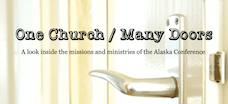By Rev. Lisa Talbott, Homer UMC

In Homer, Alaska, a traffic jam is when four cars pull up to the flashing red light at the same time, or when a moose decides to walk down the middle of the road instead of sticking to the sidewalk, or when a float plane is pulled out of Beluga Lake and towed to the airport down the street. These are some of the charms of small town life in Alaska, but on the morning of November 30, 2018, I found myself in a very different kind of traffic jam. As I pulled out of my street with my husband in his truck behind me, we were met with almost a mile of cars lined up heading into town away from the Homer Spit and the coast. A 7.1 earthquake had just hit South Central Alaska, and a tsunami warning had been issued. We were evacuating.
The tsunami warning siren screamed in background as Joe and I threw clothes, electronics, chargers, meds, and toiletries into a suitcase. Joe ran upstairs and started packing food and bottles of water while I put our two parrots in their traveling cages, gathered up spare dishes, and packed their food and water. We loaded a laundry basket with piles of blankets and extra hats, gloves, and coats. We had to get to the church and open it up. Over and over again we heard the announcement interspersed with the tsunami siren, “A tsunami warning has been issued for this area. Tune to your local radio station for more information.” As we dialed up KBBI, we heard, “Evacuate, evacuate. Go to an evacuation shelter at the Homer High School or the Homer United Methodist Church.” Police cars were starting to cruise the neighborhood, checking that everyone was packing up and heading out.
Leaving behind so many things – important documents and most of our worldly possessions – we loaded up our vehicles and headed to the church. It’s only a mile away, but most importantly, it’s up hill, away from the danger of the inundation zone.
When we got to church, we leapt into action. People were going to be cold, hungry, and scared. Joe unlocked the building, started the coffee and hot water urns, and filled all the pitchers in the church kitchen with water before setting up tables and chairs around an old boom box with the local radio station playing.
I took the parrots and all our personal belongings to my office. By this time, my phone was blowing up with texts from colleagues, friends, and family from all over Alaska and the Lower 48 wondering if we were safe. Members of the congregation were checking in, letting me know that they had evacuated our church elders from the inundation zone and taken them to their own homes on the ridge. The City Manager’s office called to make sure we were open and ready to receive evacuees. School was in session, and busses which had been dropping kids off at the high school turned right around and took them home as the school parking lot began to fill up with more and more cars as people sought shelter.
Our own parking lot began to fill up. People were staying warm in their cars, listening to the radio and talking to family on their cellphones. I started delivering cups of coffee and granola bars, chatting with people, reassuring them, offering prayer. Some came inside but many preferred to be poised for further evacuation if necessary.
The worst part were the rumors. Someone heard someone say that the water was being sucked out of a bay on Kodiak Island. Someone else heard someone else say that a 30 foot wave had been spotted from the Alaska Peninsula. Rumor control was a major part of our hospitality ministry as we welcomed scared folks in.
A family with small children arrived, and I got out the crayons. We used different colors to draw what the earthquake felt like. Big red circles for the biggest bounces all the way down to little blue lines for the aftershocks.
A couple of hours later when the all clear was issued, no one was in a hurry to leave. We still had stories to tell – where we were when the earthquake hit, how it felt, what fell down and broke or miraculously survived. What we threw in our cars when the call to evacuate came. The laughter of poking through bags and suitcases to see what was packed and what was left behind. We all wanted to stay just a little bit longer, stay together, with strangers who had become friends because of what we had just been through, who knew the fear that if a tsunami had struck, we would have lost everything except each other.
A few more cups of coffee later, and the church and parking lot emptied out. Joe and I took our tired bodies and squawking parrots home. When we walked in the front door, we said a prayer of thanks that our home was still standing, that we were safe, and that our church had once again been able to minister to people in need in our town through our presence and hospitality.

Talk about a home church.
LikeLike